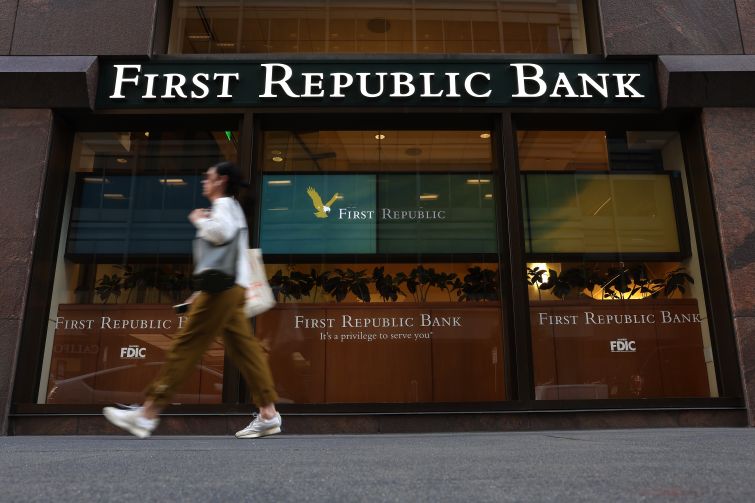Why the Spotlight on First Republic? Bank’s Exposure to Tech, CRE Causes Concern
It also doesn’t help that it’s in the same geographic area as failed Silicon Valley Bank
By Brian Pascus March 14, 2023 5:39 pm
reprints
Following the collapse of two regional banks — including Signature Bank (SBNY), one of New York City’s most active commercial real estate lenders — the market is abuzz with speculation around the health of other financiers, and First Republic Bank (FRCB) is top of mind.
The San Francisco-based lender’s stock dropped nearly 62 percent Monday on the heels of industry-wide fears of a run on deposits at additional regional banks across the nation, before stabilizing slightly Tuesday.
The sharp decline Monday came despite First Republic announcing it had received new liquidity from JPMorgan Chase (JPM) and the Federal Reserve, bringing its unused liquidity to fund operations to roughly $70 billion.
Still, Jim Herbert, executive chairman at First Republic, told CNBC’s Jim Cramer Monday that the cash infusion had worked. Herbert said the bank hadn’t seen a mass exodus of depositors, had managed to meet the withdrawal demands it did receive, and was continuing to operate as normal.
First Republic held more than $176 billion in total deposits as of Dec. 31, 2022, according to the firm’s 10-K report.
The bank’s stock price rose when trading opened Tuesday, and was up 63 percent from opening by mid-day to reach $50.97 before closing at 39.63. That price is a far cry from the $115 amount the bank’s stock carried on March 8, just prior to the onset of the regional banking crisis that began March 9 and has since rocked the market.
Still, First Republic may simply be the bank hitting headlines, sources told Commercial Observer.
“What I can tell you is that they are not the only bank being scrutinized. There’s at least 20 banks that are getting super scrutinized by the FDIC and regulators,” said Manish Shah, senior managing partner at real estate investment firm Palladius Capital Management. “The public may have latched onto First Republic because they are located in Silicon Valley and San Francisco and they happen to have a lot of private equity clients. But, if you look at it, there’s multiple banks that have regional or sector-specific focuses.”
Shah noted that some of those 20 banks under the microscope are in the Northeast and are the same size or smaller than New York City-based Signature Bank, which failed Sunday night.
“I don’t think there’s anything particularly awful about First Republic, except that it was just very easy to pick on them first,” he added.
First Republic representatives said business has been progressing as usual, despite the widespread concern around regional banking and the drop in the firm’s stock price. In a bid to minimize bloodshed, the Securities and Exchange Commission temporarily halted trading of First Republic shares on Monday morning, after the stock declined by more than 70 percent after the opening bell rang.
“We’re continuing to fully serve the needs of our clients by opening accounts, making loans, executing transactions, and delivering exceptional service at our offices and online,” said Greg Berardi, a First Republic spokesperson.
One reason First Republic has come under increased scrutiny is due to its perceived commonalities with Silicon Valley Bank, which collapsed Friday. Both banks are headquartered in San Francisco and drew clients from the region’s tech and venture capital spaces. Roughly 40 percent of First Republic’s total deposits came from the Bay Area, according to the firm’s 2022 10-K.
“It’s a Bay Area highlight with New York added,” said Aaron Jodka, director of research of U.S. capital markets at Colliers (CIGI), when asked to describe the present banking crisis. “At this point, it doesn’t seem to be spreading to other regional banks across the country. As of today, it looks like several bank stocks are under pressure, but that’s stock market momentum, perhaps, more than anything else.”
In addition to the similarities First Republic shares with SVB in its tech exposure, it also has a relatively large amount of commercial real estate loans in its portfolio, like Signature.
The bank extended $10.8 billion worth of commercial real estate loans — or 6 percent of its loan portfolio — by the end of 2022, with an average loan commitment size of $4 million, according to the firm’s 10-K.
First Republic’s loans across sectors reached $73.4 billion in 2022, up from $64.8 billion the previous year, despite the Federal Reserve raising interest rates multiple times in 2022.
“Loan originations increased in 2022 primarily due to increases in single-family, multifamily and commercial real estate lending,” according to the firm’s 10-K.
Jodka noted that regional banks have stepped in to fill the void left by bigger, money-center banks that have retrenched in the past nine months. This has made these regionals “a major source of commercial real estate lending, as well as construction lending.”
Commercial real estate has played a key role in First Republic’s investment strategy in the past year, as well.
The bank’s total investment securities rose 23 percent in 2022 to hit $31.7 billion, of which $1.1 billion were agency commercial mortgage-backed securities available for sale. The year-over-year increase in investment securities was “primarily due to purchases of agency commercial MBS and municipal securities, partially offset by paydowns and calls,” according to the 10-K.
It’s unclear exactly which asset classes make up First Republic’s commercial mortgage-backed securities loan portfolio, but the bank has made its fair share of positive headlines in the past year, signing for more than 156,000 square feet at Los Angeles’ Century City office district in July and providing a $175 million corporate bridge loan in 2021 to renovate David Geffen Hall in New York City’s Lincoln Center.
Sam Chandan, founding director of the Chen Institute for Global Real Estate Finance at New York University, said there could be a scenario in which a broader pool of depositors could grow concerned around a regional bank’s exposure to Class B or Class C office buildings and a cascade of a deposits could be withdrawn due to this perception of exposure.
“If there’s nervousness among depositors, or the general public, then the flow of deposits will be from those smaller regional banks to the larger institutions,” Chandan said. “Those are the kinds of things we’d want to look for when looking where pockets of risk might be.”
Brian Pascus can be reached at bpascus@commercialobserver.com


